The Banking System and Investment in Crimea: What is Really Happening on the Occupied Peninsula
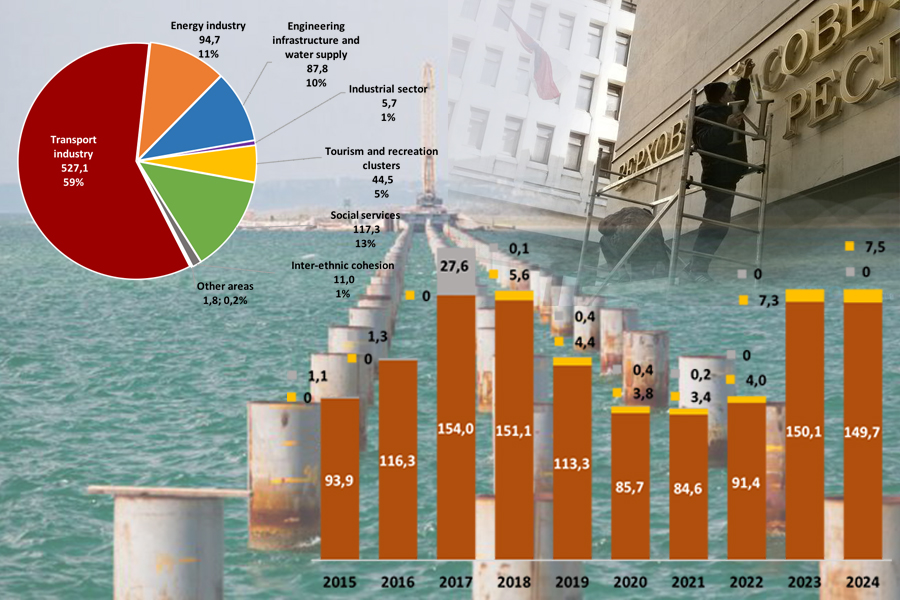
The Monitoring Group of BlackSeaNews
and the Black Sea Institute of Strategic Studies
presents an updated series of articles
«The Socio-Economic Situation in Occupied Crimea in 2014 – 2020»:
Back in the USSR. The Reverse Restructuring of the Crimean Economy
The "Trophy Economy". Militarization as a Factor of Industrial Growth
The "Trophy Economy". The Development of the Stolen Ukrainian Black Sea Shelf
The Commercial Exploitation of Marine Biological Resources
The Crimean "Trophy Economy". The Sale of Ukrainian Property
Occupied Crimea. Exports and Imports in 2014-2020
The Banking System and Investment in Crimea: What is Really Happening on the Occupied Peninsula
Water in Occupied Crimea: No Catastrophe. Just a 50-Year Step Backwards
The Crimean Budget. Small Business. Salaries and Pensions
* * *
Banking
Before the occupation, Crimea and the city of Sevastopol had an extensive network of branches of commercial banks. The total of 67 banking institutions registered in mainland Ukraine had their branches on the peninsula as well as 2 Crimean banks, the Chornomorskyi Bank Rozvytku i Rekonstruktsii and the Sevastopolskyi Morskyi Bank.
The occupying state planned to use Ukrainian financial institutions to mitigate its problems of the “transition period”. However, none of the Ukrainian banks with independent branches in Crimea consented to continue working in the occupied territory under the Russian legislation, so Russian banks tried to fill the void.
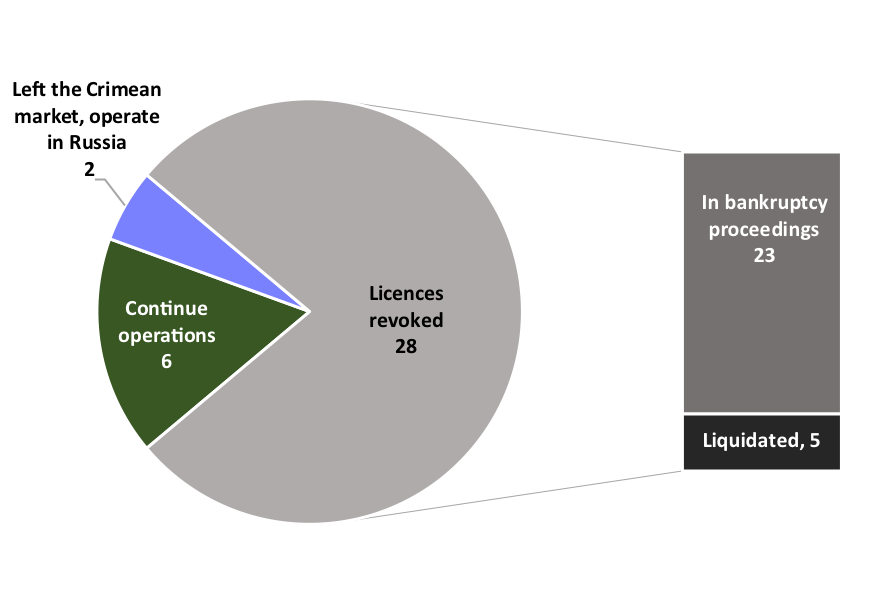
During the occupation, at different times, 34 Russian banks started operations in Crimea. In addition, 2 local banks began operations under the Russian jurisdiction bringing the total to 36 (Chart 1).
As of today, 28 banks have had their licences revoked. Out of these, 5 banks have already been liquidated, 23 are currently in bankruptcy proceedings.
2 Russian banks that left Crimea after a brief attempt at work are still operating in Russia.
As of 1 September 2020, only 6 Russian banks remained on the peninsula. All of them are now under international sanctions.
The banks that are currently operating in Crimea are presented in Table 1.
Table 1. Basic information about banking institutions operating in occupied Crimea
|
|
Bank name | Headquarters location | Presence in Crimean cities | Net assets as of 1 August 2020, million USD | Place in the financial rankings of Russian banks | International sanctions |
|---|---|---|---|---|---|---|
|
1 |
PAO Russian National Commercial Bank (RNCB) | Simferopol | Alushta Armiansk Bakhchysarai Dzhankoi Yevpatoriia Kerch Krasnoperekopsk Saky Sevastopol Simferopol Sudak Feodosiia Yalta |
3 696 |
31 |
The USA since 11 March 2015. The EU since 30 July 2014. Ukraine since 16 September 2015. |
|
2 |
AO Sevastopolskiy Morskoy Bank | Sevastopol | Alushta Armiansk Bakhchysarai Yevpatoriia Kerch Krasnoperekopsk Saky Sevastopol Simferopol Sudak Feodosiia Yalta |
49 |
259 |
The USA since 22 December 2015. Ukraine since 14 May 2018. |
|
3 |
AO Chernomorskiy Bank Razvitiya i Rekonstruktsii (ChBRR) | Simferopol |
АAlushta |
95 |
212 |
The USA since 20 June 2017. Ukraine since 14 May 2018. |
|
4 |
AO GENBANK | Simferopol | Alushta Armiansk Bakhchysarai Dzhankoi Yevpatoriia Kerch Krasnoperekopsk Saky Sevastopol Simferopol Sudak Feodosiia Yalta |
752 |
94 |
The USA since 22 December 2015. Ukraine since 16 September 2015. |
|
5 |
AO Aktsionernyy Bank Rossiya | St. Petersburg | Alushta Dzhankoi Yevpatoriia Kerch Krasnoperekopsk Saky Sevastopol Simferopol Feodosiia Yalta |
14 775 |
14 |
The USA since 20 March 2014. Ukraine since 16 September 2015. |
|
6 |
AO Commercial Bank Industrialnyy Sberegatelnyy Bank | Moscow | Kerch Sevastopol Simferopol Yalta |
83 |
221 |
The USA since 20 June 2017. Ukraine since 16 September 2015. |
The total net assets of the banks currently operating in Crimea are about USD 19.5 billion. However, 14.8 billion of this amount is the assets of the Aktsionernyy Bank Rossiya (Chart 2).
It is the bank headquartered in St. Petersburg, placed between 10th and 20th in the rankings of Russian banks, and specialised, according to Russian financial analysts, "mainly in providing services to large corporate clients, including enterprises and organizations that are part of the largest Russian strategic companies".
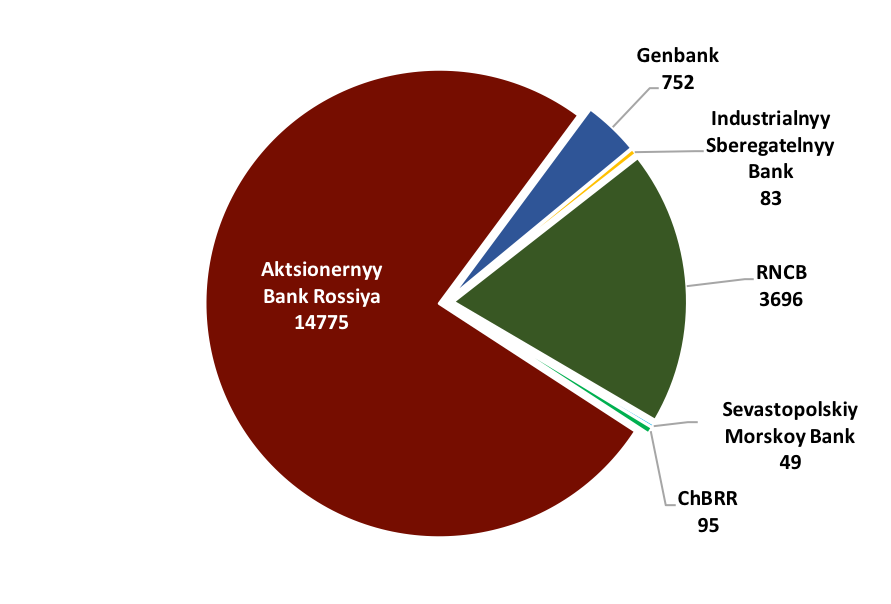
Sanctions prevent it from being an influential financial institution in the international market. Since the development of financial services in Crimea is not appealing to the bank, it mainly looks after the financial interests of its beneficiaries, Yuri Kovalchuk, Gennady Tymchenko, Oleksiy Mordashov, Serhiy Roldugin, and others who have already acquired a large amount of seized Ukrainian property on the occupied peninsula.
Another Russian bank (there are currently only two banks with "non-Crimean residence" in Crimea) does not deserve much attention due to its small size and scale.
As a result of sanctions, all the large Russian banks that used to operate in Crimea before the occupation, namely Sberbank, Alfa-Bank, and VTB, have since stopped operations there and do not intend to resume them.
Of the four "Crimean" banks, RNСB is the largest by asset size and the number of branches. It serves as the "main bank" of Crimea, provides settlement and cash services to a large number of legal entities, and is the only bank that processes payments of individuals.
Incidentally, in the near future, we can expect a further reduction in the number of banks in Crimea. According to Russian financial analysts, the Sevastopolskiy Morskoy Bank, which has been managed by the interim administration since January 2020, is planned to be merged with RNСB. In April 2020, by order of the Russian Central Bank, the authorised capital of the Sevastopolskiy Morskoy Bank was reduced to 1 (one) rouble.
Investment
According to Rosstat, during the years of the occupation, investment in fixed capital in Crimea and Sevastopol has totalled $8.6 billion and $1.9 billion respectively. Of this investment, $6.03 billion (70.2%) in Crimea and $1.34 billion (71.6%) in Sevastopol were funded from the state budget (see Chart 3).
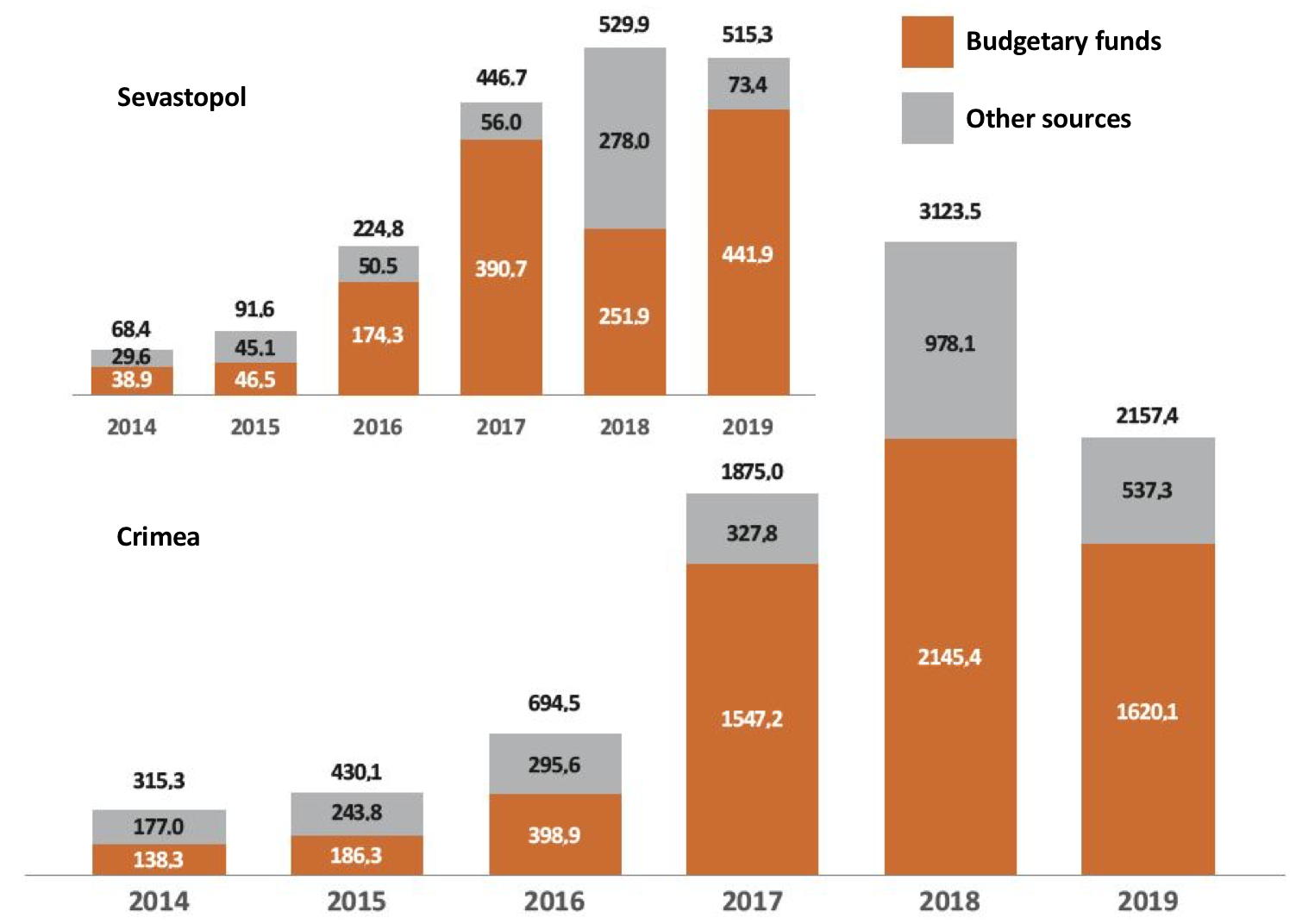
This was mainly the investment in the facilities under the so-called Federal Target Programme "The Socio-Economic Development of the Republic of Crimea and Sevastopol until 2020" (the FTP).
The correlation between the level of financing capital investment under the Federal Target Programme and the amount of investment according to official statistics is shown in Chart 4.
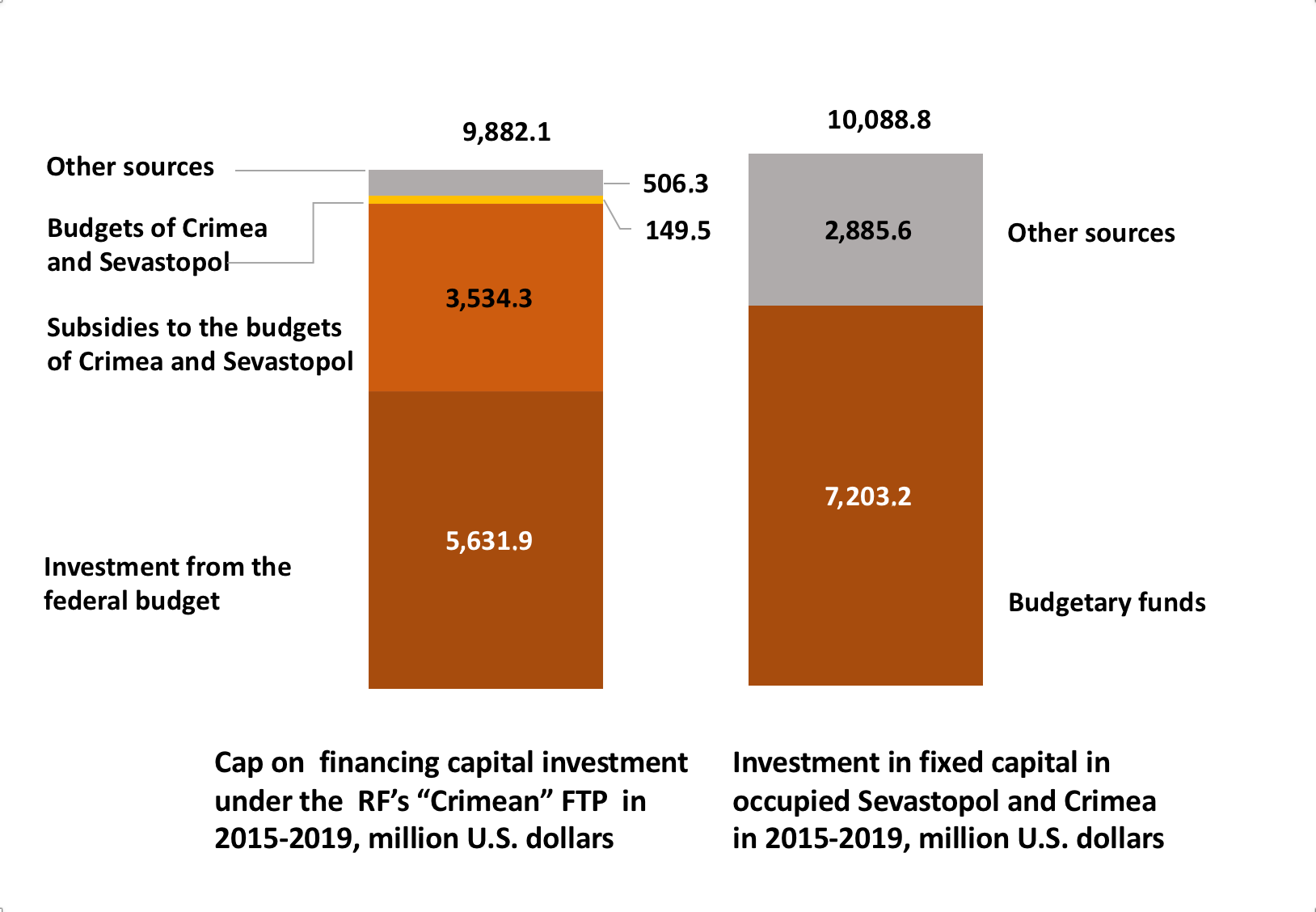
In addition to 70% of budget investment in fixed capital, in Figures 3 and 4 we can see investment "from other sources".
The "other sources" of investment in Crimea and Sevastopol are as follows:
-
investment in the construction of road and energy infrastructure, other facilities under the FTP, the funds for which were allocated not directly from the budget of the Russian Federation, but through Russian state and quasi-private corporations or bank loans;
-
investment from enterprises of the military-industrial complex of the RF in military production at Ukrainian plants seized as a result of the occupation;
-
private investment in housing construction for customers from the RF is almost the only type of demand-oriented investment projects. The customers, in turn, represent a specific group of Russian military and government officials transferred to the peninsula. Also, private investment in trade and warehouse infrastructure of wholesale and retail businesses from the regions of the RF is made.
What the "Crimean" Federal Target Programme Finances
The Russian Federal Target Programme "The Socio-Economic Development of the Republic of Crimea and the City of Sevastopol until 2020" was adopted in August 2014, adjusted several times, and finally extended until 2024.
The planned amount of funding for the programme as of 27 July 2020 was 1257.3 billion roubles, including 1190.1 billion roubles from the federal budget, 36 billion roubles from the budgets of the “constituent entities of the Russian Federation”, 311.2 billion roubles from extrabudgetary funds.
Capital investment under the programme amounts to 1121.9 billion roubles, the remaining 135.4 billion roubles have been allocated for “other needs", such as urban planning documentation, the Era-Glonass system, the creation of communication channels "for the benefit of the Ministry of Defence of the Russian Federation, federal executive bodies, other bodies and organizations, communications operators to ensure national security and defence and law enforcement".
As for the goals of the Federal Target Programme and the specific projects that have been funded, the main objective of the programme is to remove the infrastructure constraints that have arisen as a result of the occupation of Crimea. They are:
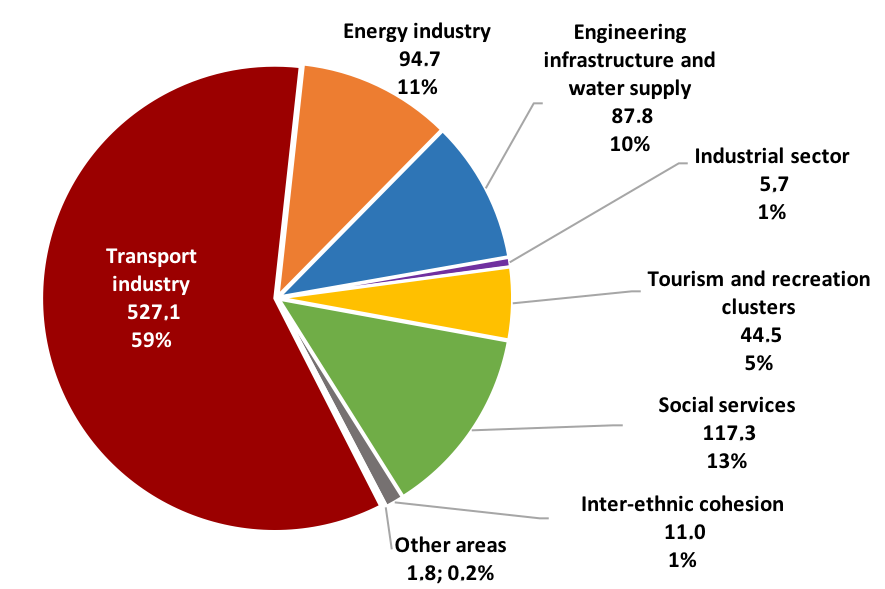
-
the removal of transport infrastructure constraints: the construction of the bridge across the Kerch Strait, the reconstruction of Simferopol airport, the construction of roads to increase transport accessibility of the Crimean Peninsula, and reformatting the existing transport corridors for passenger and freight traffic with the focus on Russia, the arrangement of checkpoints (about 60% of the funds);
-
the removal of energy supply constraints: the removal of network constrains, own energy generation (at least 11% of the funds);
-
the removal of engineering infrastructure constraints: the creation of a water supply system (at least 10% of the funds).
Other areas of funding have big names, however, far less funds have been allocated for them:
-
the formation of an industrial complex, i.e. the creation of the infrastructure for industrial parks (5.7%);
-
the formation of tourist and recreational clusters (5%);
-
social services (13%);
-
ensuring inter-ethnic cohesion (1%);
-
the protection of the population and territories from emergencies and other areas of funding account for only 0.2% of the amount of capital investment.
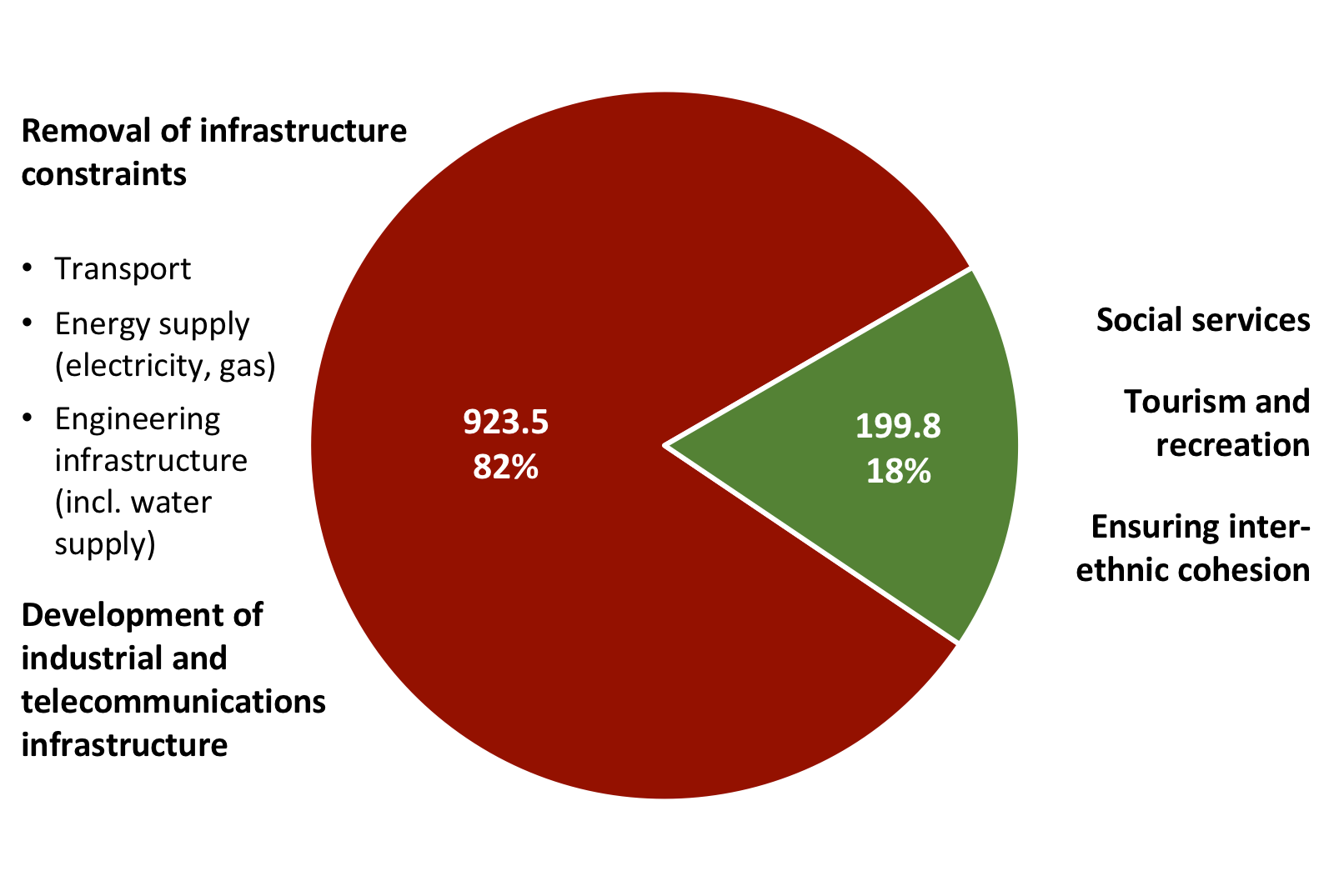
The latest funds added to the amount of funding for the programme in July 2020 were not allocated for specific purposes, so the structure of funding for the Federal Target Programme today looks as shown in Chart 6.
It is clear that the priorities have not changed: megaprojects to overcome infrastructure constraints and measures to create telecommunications and industrial infrastructure account for more than 80% of the funds.
The main source of funding for the target programme has been and will remain the federal budget of Russia (see Chart 7). Funds from extrabudgetary sources of the FTP are defined in the programme as "credit, various types of loans, as well as own funds of investor companies.”
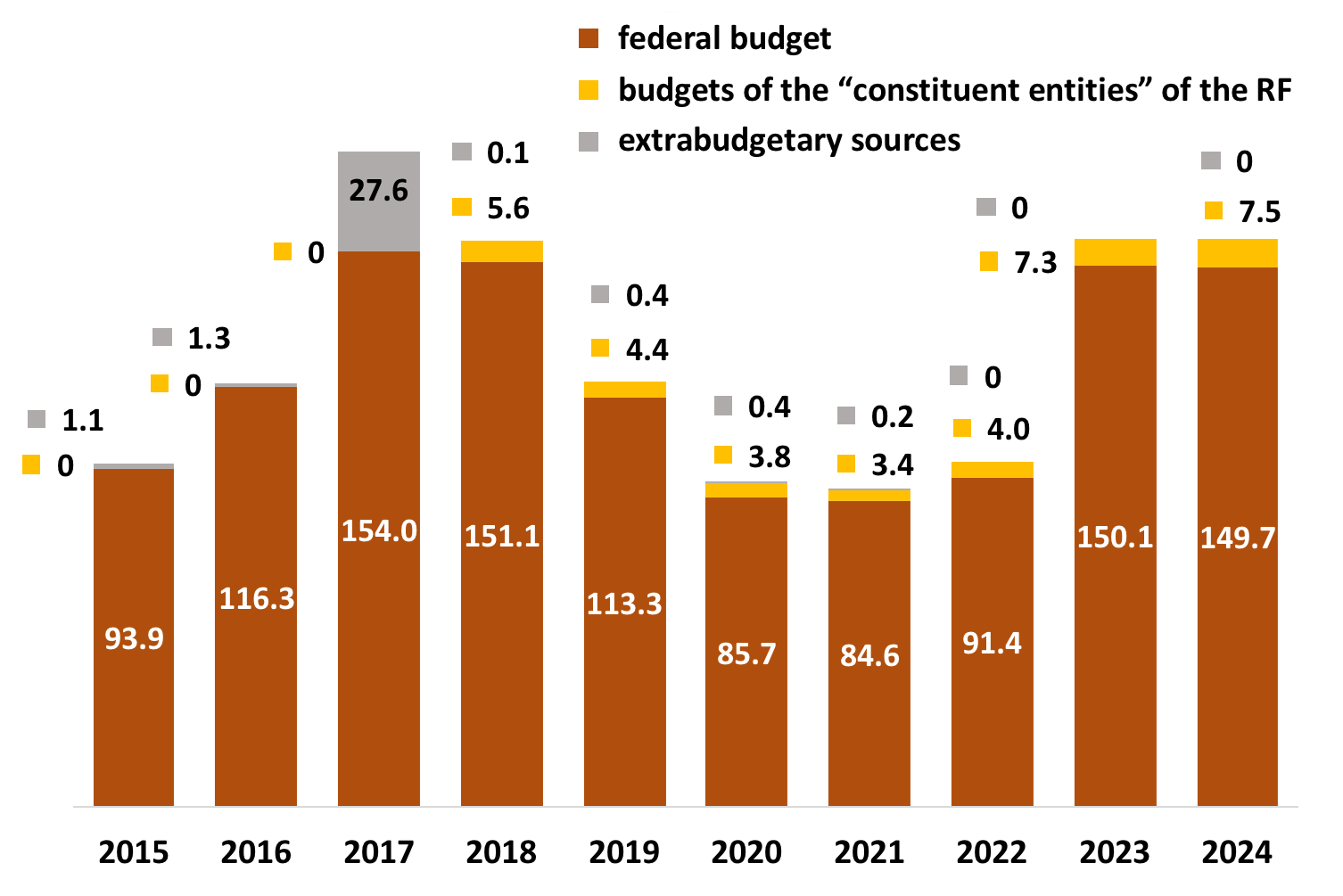
* * *
Thus, the state of the banking system of Crimea and the real nature of investment in the occupied territory indicates that under international sanctions Crimea by definition cannot become attractive for investors. It has been and will remain a financial burden for the budget of the occupying power.
* * *
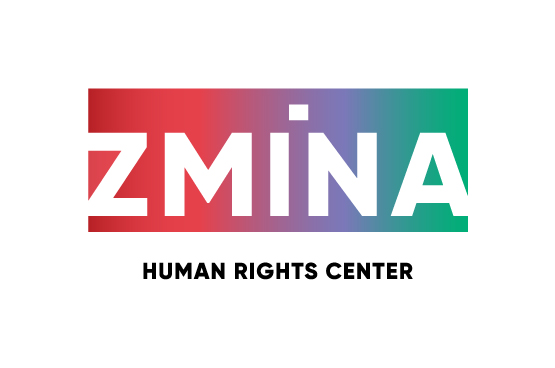
This article has been published with the support of ZMINA
Human Rights Centre.
The content of the article is the sole responsibility of the authors.
More on the topic
- 21.08.2023 Peculiarities of the 2023 Crimean Holiday Season — a «Tourism» in Camouflage
- 06.08.2023 Crimea During the Great War. Part 2. Extreme Tourism or «New Types of Tourism» and Tourist Numbers (2)
- 21.07.2023 Crimean Titan: Under a Russian Holding or a Ukrainian Tank?
- 12.06.2023 Crimea during the Great War. The situation in the occupied Crimea in 2022-2023. Military Context (1)
- 23.11.2021 Occupied Crimea. Exports and Imports / 2014-2021
- 23.11.2021 Water in Occupied Crimea / 2014-2021
- 23.11.2021 The Crimean Budget. Small Business. Salaries and Pensions / 2014-2021
- 23.11.2021 The "Trophy Economy". The Commercial Exploitation of Marine Biological Resources in the Black Sea and the Sea of Azov / 2014–2021
- 21.11.2021 The "Trophy Economy". Militarization as a Factor of Industrial Growth / 2014-2021
- 21.11.2021 Back in the USSR. The Reverse Restructuring of the Crimean Economy / 2014-2021
- 20.11.2021 The "Trophy Economy". The Development of the Stolen Ukrainian Black Sea Shelf / 2014-2021
- 20.11.2021 The Occupied Crimean Tourism / 2014-2021